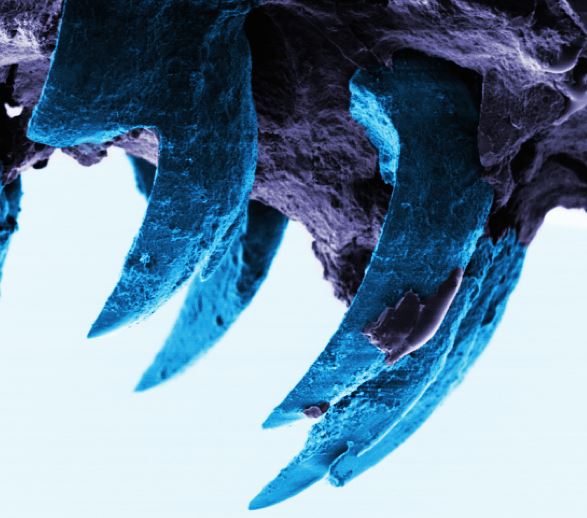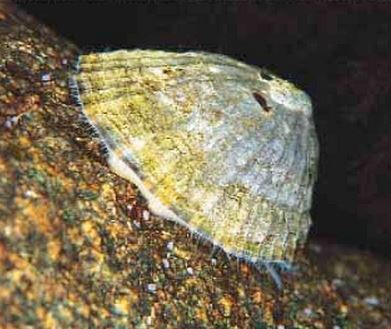Limpet teeth are so strong that they could be used to make Formula 1 racing cars, boats and airplanes stronger, researchers say. Limpet teeth contain the strongest natural material on Earth – even stronger than spider silk.
A team of scientists from the University of Portsmouth wrote about their latest study in the journal Interface (citation below).
Limpets are small salt and fresh water creatures that look like snails and stick to rocks. The majority of limpets live in seawater.

Limpet teeth contain the mineral goethite. (Photo: University of Portsmouth)
They clamp tightly onto rocks when the tide is low, using their muscular foot to apply suction combined with the effect of adhesive mucus. At high tide they wander about up to three feet (1 metre) from their original spot.
When the tide goes down again they return to the very same spot.
They feed by grazing on algae found on the surface of rocks, and use a radula, a ribbon-like tongue with rows of teeth, to scrape films of algae on the rock. They move about by rippling the muscles of their foot in a wave-like motion.
Atomic force microscopy
Professor Asa Barber, from the School of Engineering, University of Portsmouth, and colleagues used atomic force microscopy to observe the mechanical behavior of limpet teeth. Atomic force microscopy, which is more than 1,000 times better than optical diffraction, provides pictures of atoms on/in surfaces.
Prof. Barber said:
“Nature is a wonderful source of inspiration for structures that have excellent mechanical properties. All the things we observe around us, such as trees, the shells of sea creatures and the limpet teeth studied in this work, have evolved to be effective at what they do.”
“Until now we thought that spider silk was the strongest biological material because of its super-strength and potential applications in everything from bullet-proof vests to computer electronics but now we have discovered that limpet teeth exhibit a strength that is potentially higher.”

A limpet stuck to a rocky surface. Unlike mussels and barnacles, limpets move around when the tide is low. (Image: Wembury Marine Centre)
Mineral goethite found in Limpet teeth
Limpet teeth contain goethite, the researchers said. It is a dark or yellowish-brown mineral consisting of hydrated iron oxide. It is the main component of rust and bog iron. As the limpet grows, so does its concentration of goethite. The mineral was named after Johann Wolfgang von Goethe (1749–1832), a German polymath (a person of wide knowledge) and poet.
Prof. Barber said:
“Limpets need high strength teeth to rasp over rock surfaces and remove algae for feeding when the tide is in. We discovered that the fibres of goethite are just the right size to make up a resilient composite structure.”
Prof. Barber and team believe the fibrous structures of limpet teeth could be adapted and used for manufacturing the hulls of boats and airplanes, and possibly for some high-performance engineering applications of Formula 1 racing cars.
Prof Barber explained:
“Engineers are always interested in making these structures stronger to improve their performance or lighter so they use less material.”
For limpet teeth, size doesn’t matter
Most materials become more brittle and/or fragile the larger they are. This is not the case with limpet teeth. They found all of them to have the same strength, not matter how big or small they were.
The scientists used a technique they had developed recently to examine samples of material nearly 100 times thinner than the diameter of a human hair.
Prof. Barber said:
“The testing methods were important as we needed to break the limpet tooth. The whole tooth is slightly less than a millimetre long but is curved, so the strength is dependent on both the shape of the tooth and the material. We wanted to understand the material strength only so we had to cut out a smaller volume of material out of the curved tooth structure.”
“Biology is a great source of inspiration when designing new structures but with so many biological structures to consider, it can take time to discover which may be useful.”
Bioinspiration is the study of processes and designs that exist in nature, and then attempting to find ways of using them to solve human problems.
Reference: “Extreme strength observed in limpet teeth,” Asa H. Barber , Dun Lu & Nicola M. Pugno. Interface. DOI: 10.1098/rsif.2014.1326 Published 18 February 2015.
BBC Video – Limpet Teeth Strongest Biological Material

